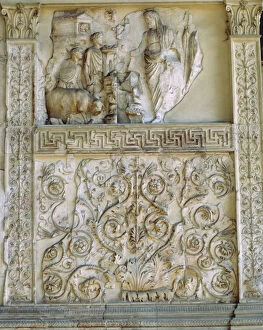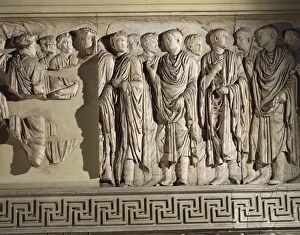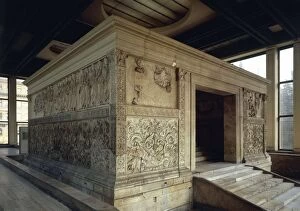Ara Pacis Augustae Collection
The Ara Pacis Augustae, an altar built between 13 and 9 B. C
All Professionally Made to Order for Quick Shipping
The Ara Pacis Augustae, an altar built between 13 and 9 B. C. To celebrate the peace established by Augustus, is a magnificent testament to the power and grandeur of ancient Rome. The marble panels that adorn its walls depict various scenes from Roman mythology and religious rituals. One such panel shows the Procession of Priests on the north wall of the Ara Pacis. These priests, adorned in elaborate robes, march solemnly towards the altar, carrying sacred objects and performing their duties with reverence. On the south wall, another panel depicts a vibrant Procession scene. Figures dressed in flowing garments can be seen walking alongside chariots pulled by majestic horses. This lively depiction captures the energy and excitement of a ceremonial procession. Aeneas sacrificing to the Penates is depicted on the western wall of this monumental structure. Aeneas, one of Rome's legendary founders, offers sacrifices to his household gods as an act of devotion and gratitude for their protection. The exterior view showcases a stunning stairway leading up to this architectural marvel. Dating back to 13th-9th century BC (photo), it serves as a reminder of how ancient civilizations laid foundations for future greatness. Another section on the north wall portrays yet another Procession scene - perhaps emphasizing its significance in Roman society or highlighting different aspects within these events. The Tellus panel presents an image symbolizing fertility and abundance through Mother Earth herself. It represents prosperity brought about by peace during Augustus' reign. Through illustrations depicting its reconstruction in modern times, we gain insight into what this awe-inspiring monument would have looked like during its prime in first-century BC Rome. Lastly, there is a relief showing Aeneas sacrificing to Penates directly on Ara Pacis Augustae itself—an altar where Romans paid homage to their deities while also celebrating peace under Augustus' rule—a powerful visual representation tying together religion and political stability.

















